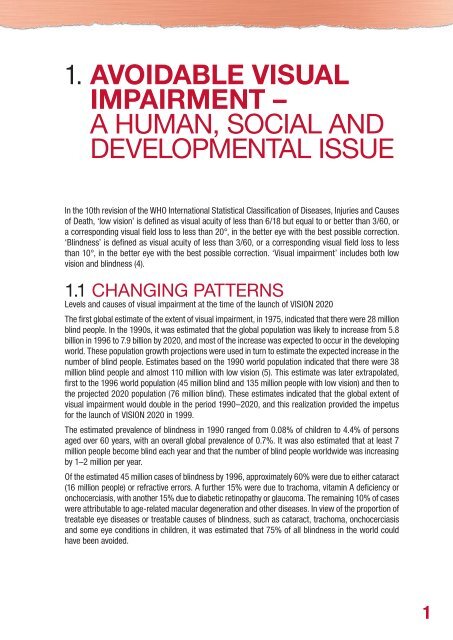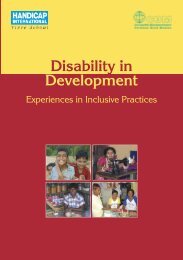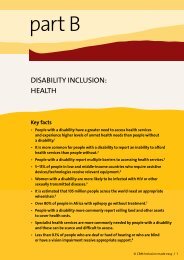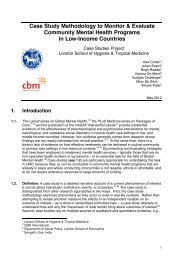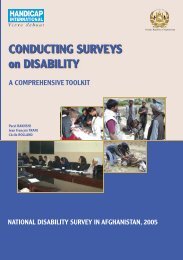Vision 2020 - World Health Organization
Vision 2020 - World Health Organization
Vision 2020 - World Health Organization
Create successful ePaper yourself
Turn your PDF publications into a flip-book with our unique Google optimized e-Paper software.
1. AVOIDABLE VISUAL<br />
IMPAIRMENT –<br />
A HUMAN, SOCIAL AND<br />
DEVELOPMENTAL ISSUE<br />
In the 10th revision of the WHO International Statistical Classifi cation of Diseases, Injuries and Causes<br />
of Death, ‘low vision’ is defi ned as visual acuity of less than 6/18 but equal to or better than 3/60, or<br />
a corresponding visual fi eld loss to less than 20°, in the better eye with the best possible correction.<br />
‘Blindness’ is defi ned as visual acuity of less than 3/60, or a corresponding visual fi eld loss to less<br />
than 10°, in the better eye with the best possible correction. ‘Visual impairment’ includes both low<br />
vision and blindness (4).<br />
1.1 CHANGING PATTERNS<br />
Levels and causes of visual impairment at the time of the launch of VISION <strong>2020</strong><br />
The fi rst global estimate of the extent of visual impairment, in 1975, indicated that there were 28 million<br />
blind people. In the 1990s, it was estimated that the global population was likely to increase from 5.8<br />
billion in 1996 to 7.9 billion by <strong>2020</strong>, and most of the increase was expected to occur in the developing<br />
world. These population growth projections were used in turn to estimate the expected increase in the<br />
number of blind people. Estimates based on the 1990 world population indicated that there were 38<br />
million blind people and almost 110 million with low vision (5). This estimate was later extrapolated,<br />
fi rst to the 1996 world population (45 million blind and 135 million people with low vision) and then to<br />
the projected <strong>2020</strong> population (76 million blind). These estimates indicated that the global extent of<br />
visual impairment would double in the period 1990–<strong>2020</strong>, and this realization provided the impetus<br />
for the launch of VISION <strong>2020</strong> in 1999.<br />
The estimated prevalence of blindness in 1990 ranged from 0.08% of children to 4.4% of persons<br />
aged over 60 years, with an overall global prevalence of 0.7%. It was also estimated that at least 7<br />
million people become blind each year and that the number of blind people worldwide was increasing<br />
by 1–2 million per year.<br />
Of the estimated 45 million cases of blindness by 1996, approximately 60% were due to either cataract<br />
(16 million people) or refractive errors. A further 15% were due to trachoma, vitamin A defi ciency or<br />
onchocerciasis, with another 15% due to diabetic retinopathy or glaucoma. The remaining 10% of cases<br />
were attributable to age-related macular degeneration and other diseases. In view of the proportion of<br />
treatable eye diseases or treatable causes of blindness, such as cataract, trachoma, onchocerciasis<br />
and some eye conditions in children, it was estimated that 75% of all blindness in the world could<br />
have been avoided.<br />
1


